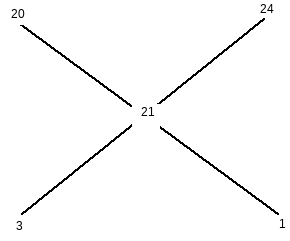Mixtures and Alligations
Mixtures and Alligations - The method to solve some specific kind of problems where the mixing of things is taking place is alligation. It is a common topic asked in the quantitative aptitude section of various government and competitive exams. By using alligation we can solve some specific kind of questions related to percentages, profit-loss, time, speed, & distance, mixtures, etc. Every arithmetic chapter has some specific problems where we can use alligation to crack the problems in minimum time. There is another way to understand things that any question where the quadratic equation is formed by the statement, that particular question can be solved easily using alligation.

How to prepare mixtures and alligations?
Before coming to this, one should have studied ratios and proportions.
Learn to identify the questions which can be cracked using alligation.
Learn to solve the constant fluid & removal-replacement concept in mixture question.
Identify the problems in every chapter which can be solved using alligation, to have better clarity of alligation.
Solve the questions from past papers to know the exact pattern asked in the examinations.
Take online tests to know about the trending pattern in the examinations.
Example:- A wheat having price 20/kg mixed with another wheat having price 24/kg to gain the mixture which cost 21/kg. Find the ratio in which these should be mixed.

Things to be kept in mind while applying alligation,
All the 3 things which you are using for mixture should always be in the same units.
The number in the middle would always be a value between mixed values. Let’s understand this from the above diagram, the middle number can never be less than 20, not more than 24.
Let’s talk about mixtures now, the questions in mixtures will be related to the addition and removal of fluids. The question based on mixtures would be in the following formats:-
When you are adding fluid from the mixture
When you are removing fluid from the mixture
When you are removing & replacing the same amount of fluid
Mixtures alligation is a must-read chapter for the competitive exams as we can use alligation to solve the problems of multiple chapters in Quantitative Aptitude.
Practice questions of Alligation and mixture
Q 1. The minimum quantity of milk in litres (in whole number) that should be mixed in a mixture of 60 litres in which the initial ratio of milk to water is 1 : 4 so that the resulting mixture has 15% milk is
3
4

This is not possible(Correct)
5
Q 2. In what ratio must rice at Rs. 9.30 per kg be mixed with rice at Rs. 10.80 per kg so that the mixture be worth Rs10 per kg?
 (Correct)
(Correct)



Q 3.How much water must be added to 60 litres of milk at 3/2 litres for Rs. 20 so as to have a mixture worth Rs. 32/3 litres ?

 (Correct)
(Correct)


Q 4. How many kg of wheat costing R8 must be mixed with 36 kg of rice costing Rs. 5.40 per kg so that 20% gain may be obtained by selling the mixture at Rs. 7.20 per kg?



 (Correct)
(Correct)
Q 5. The milk & water in two vessels A & B are in the ratio 4:3 & 2:3 resp. In what ratio, the liquids in both the vessels are mixed to obtain a new mixture in vessel C containing half milk & half water?
 (Correct)
(Correct)



Q 6.In what ratio must a grocer mix two varieties of pulses costing Rs.15 & Rs. 20 per kg respectively so as to get a mixture worth Rs. 16.50 per kg?


 (Correct)
(Correct)

Q 7.Find the ratio in which rice at Rs. 7.20 a kg be mixed with the rice at Rs. 5.70 a kg to produce a mixture worth Rs. 6.30 a kg.

 (Correct)
(Correct)


Q 8.The cost of A chocolate is Rs. 14 per kg & B chocolate is Rs. 20 per kg. If both A & B are mixed in the ratio 2:3, then the price per kg of the mixed variety of chocolate is:
 (Correct)
(Correct)



Q 9.In what ratio must a grocer mix two varieties of tea worth Rs. 60 a kg & Rs. 65 a kg so that by selling a mixture at Rs. 68.20 a kg, he may gain 10%?
 (Correct)
(Correct)



Q 10.Two vessels A & B contain spirit & water mixed in the ratio 5:2 & 7:6 respectively. Find the ratio in which these mixture be mixed to obtain a new mixture in vessel C containing spirit & water in the ratio 8:5?



 (Correct)
(Correct)
Q 11.A container contains 40L of milk. From this container 4L of milk was taken out & replaced by water. This process was repeated further 2 times. How much milk is now contained in the container?



 (Correct)
(Correct)
Q 12.How many kg of brand A coffee must be mixed with 126 kg of brand B coffee such that the cost of the mixture is Rs. 24 per kg? Per kg prices of A and B are Rs. 36.60 and Rs. 17.10 respectively.


 (Correct)
(Correct)

Q 13.16 litres of draught beer contains 216 calories and 16 litres of Kingfisher contains 174 calories. If an 8 litre mixture of both beers contains 101 calories, the fraction of Kingfisher beer in the mixture is
2/5

 (Correct)
(Correct)

Q 14.A merchant purchased two qualities of pulses at the rate of Rs. 200 per quintal and Rs. 260 per quintal. In 52 quintals of the second quality, how much pulse of the first quality should be mixed so that by selling the resulting mixture at Rs. 300 per quintal, he makes a profit of 25%?
100 quintals

 (Correct)
(Correct)

Q 15. Ravi covered a distance of 300 km in 20 hours in 2 parts. He covered the first part by a car which was driven at a speed of 20 km/hr and the second part by an auto rickshaw that was driven at a speed of 12 km/hr. The ratio of the distances covered by Ravi in the two parts is:
 (Correct)
(Correct)



Q 16.Two vessels contain a mixture of diesel and kerosene. In the first vessel, the ratio of diesel to kerosene is 8 : 3 and in the second vessel the ratio is 5 : 1. A 35 litre drum is filled from these vessels so as to contain a mixture of diesel and kerosene in the ratio 4 : 1. How many liters are taken from the second vessel?
11 litres

 (Correct)
(Correct)

Q 17.Alloy 'CuZ' has Cu : Zn 4 : 1 while alloy 'ZiC' has Cu : Zn 1 : 3. One melting 10 kg of CuZ with 16 kg of Zic and some amount of pure Cu, a new alloy 'Cuzec' with Cu : Zn 3 : 2 is obtained. The weight of Cuzec is

 (Correct)
(Correct)
None of these

Q 18.How many kgs of Basmati rice costing Rs. 42/kg should a shopkeeper mix with 25 kgs of ordinary rice costing Rs. 24 per kg so that he makes a profit of 25% on selling the mixture at Rs. 40/kg?
 (Correct)
(Correct)12.5 kgs



Q 19. From 40 liters of 2: 3 milk-water solutions, 5 liters are withdrawn and replaced by 5 liters of water. Now, 8 liters are withdrawn and replaced by 8 liters of water. Finally, 10 liters are withdrawn and replaced by 10 liters of water. What is the ratio of water to milk in the solution now?

 (Correct)
(Correct)


Q 20.18 liters are drawn from a bucket full of pure milk, and it is then completely filled with water. 18 litres of the mixture are again drawn and the bucket is again filled completely with water. The ratio of the volume of water now left in the bucket to that of the milk in it is 9 : 16. What is the total capacity (in litres of the bucket)?


90 (Correct)
55

Q 21.From 90 liters of 4: 5 milk-water mixture, 15 liters are taken out and replaced by the same amount of water. This process is repeated once more. Now, 9 liters of the mixture is taken out and replaced by the same amount of milk. The amount of water at the end of the third cycle is how much percent of the amount of water at the end of the second cycle?
20%
90% (Correct)
201.6%
49.6%
10%
Q 22.From a cask of milk containing 30 litres, 6 litres are drawn out and the cask is filled up with water. If the same process is repeated a second, then a third time, what will be the number of litres of milk left in the cask?



 (Correct)
(Correct)
Q 23.There are some shepherds and their sheep in a grazing field. The no. of total heads are 60 and total legs are 168 including both men and sheep. The no. of sheep are:
20
26
24 (Correct)
36
18
Q 24.Gold is 19 times as heavy as water and copper 9 times. In what ratio should these metals be mixed so that the mixture may be 15 times as heavy as water?


 (Correct)
(Correct)

Q 25. In a class of 30 students, the average weight of boys is 20 kg and the average weight of the girls is 25 kg. The fraction of boys out of the total students of the class is



Data insufficient (Correct)

Applications for Admissions are open.
Apply for Online M.Com from Manipal University
